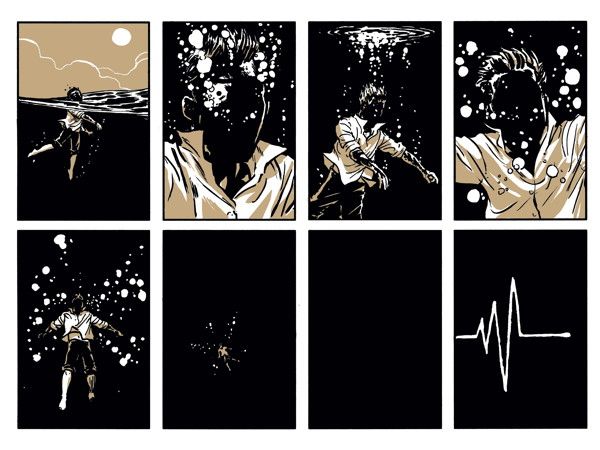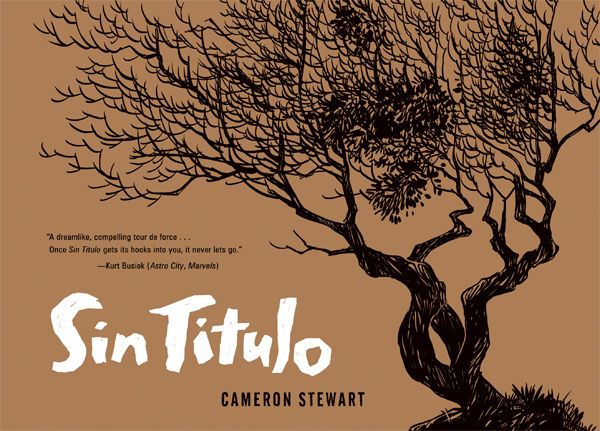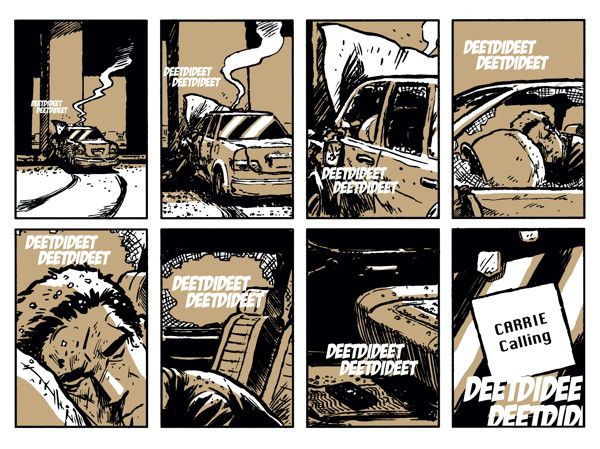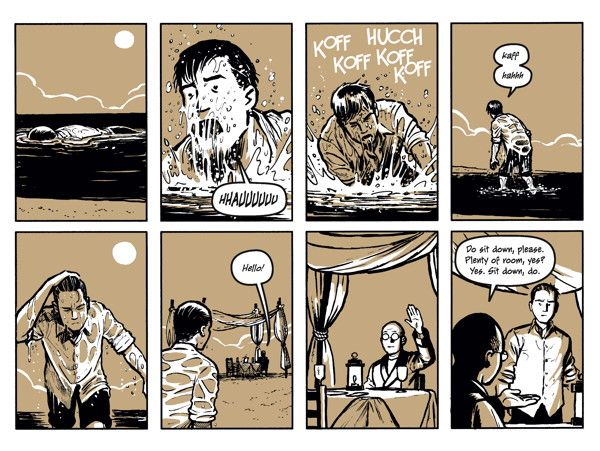Cameron Stewart is best known for his work with Ed Brubaker on Catwoman and with frequent collaborator Grant Morrison on Batman and Robin, Seaguy and Seven Soldiers. But over the past six years, he's also struck out on his own, writing and drawing the neo-noir mystery thriller Sin Titulo, a webcomic that's earned the cartoonist an Eisner and a Shuster award.
Dark Horse published a print collection of the series in September, introducing Sin Titulo to a new audience. In support of that release, Stewart embarked last month on a 13-city tour that's taking him across Canada and the United States before ending up in England. Ahead of tonight's stop at Challenger Comics + Conversation in Chicago, guest contributor Dave Scheidt spoke with Stewart about the origins of the largely improvised Sin Titulo, the series' place within the worlds of print and webcomics, his eventual return to Seaguy, and his plans for a fantasy epic called Niro.
Note: A shorter version of this interview originally appeared on The Huffington Post.
Dave Scheidt: Tell us a little about Sin Titulo. You started doing it in 2007, right?
Cameron Stewart: That’s right, I began it in 2007. It started as a webcomic that I was doing. It was a book I had begun just because I was just trying to do some work that was my own. I was sort of frustrated with doing a lot of work for hire; I wanted to just do a work of my own. So along with a bunch of other friends who were feeling the same way, we launched a group of webcomics. I started doing it weekly, putting pages up every Sunday. It took a while; it took about six years for it to actually be finished because I was doing it basically in my spare time. It took a while to do, just because I had a lot of work-for-hire stuff I had to do, but once it was complete Dark Horse offered to publish it into a book.
The two biggest influences are David Lynch and Haruki Murakami, the Japanese novelist. It’s sort of a neo-noir mystery thriller with elements of autobiography and supernatural horror.
You’ve said that working on this weekly, you initially had a basic gist of the storyline but you kind of improvised a lot of it week to week?
Yeah. Actually, I didn’t even know what the ending was going to be. When I started it, I didn’t even know where the start was going to be. I didn’t really have a clear idea of what I wanted it to be. I had seen David Lynch’s Inland Empire, and I knew from just reading about it that he made that movie largely improvisational. He just went shooting a bunch of footage every day and kind of seeing how it came together, and I was really inspired from that. That’s what I started doing. I had a dream one night and I just drew it into a little eight-panel comic strip. I used that as sort of the first page and started kind of making it up as a I went along. At the beginning it was kind of exhilarating and fun and to play a game of “and then what … and then what,” and about halfway through I realized I needed to tie it all together and sort of take responsibility for the mess that I made, and write a conclusion.
Wow, that’s especially weird because reading through it, it never felt to me like a stream-of-consciousness type of work. it really feels like a story you set out to do, which is no small feat.
Oh. Thank you!
I hate to admit this, but I had no idea this comic existed until I saw it on the shelves at Challengers, and I’m fairly familiar with your work. I just assumed it was a new graphic novel you released that I somehow didn’t hear about.
It is new to a lot of people because there are a lot of people out there who just don’t like reading webcomics. There’s an opportunity there to treat it as a new book.
RELATED: Cameron Stewart leaving a trail of original art in major cities
There definitely seems to be a distinction between webcomics readers and traditional comics readers. Where do you think Sin Titulo fits between those two worlds?
A lot of webcomics seem to be these humor strips or long-running, almost soap opera-type things. I didn’t want it to be a humor strip or something that I’d want to run indefinitely. I set out to do it as a finite story, even though I started it not knowing what it was gonna be. The end game was always to have it in print. I definitely like using the Internet for publishing comics -- I think it’s a really, really valuable too, and in a way I think it’s much better than self-publishing. It’s closer in spirit to typical, printed graphic novels compared to other webcomics.
Yeah, It seems like a lot people already have a preconceived notion of what webcomics are. It’s great that more and more that different genres are popping up, since it’s just as capable a medium as print comics.
Absolutely. I think a lot of people kind of look down on webcomics. I won an Eisner Award for it [Sin Titulo] for the category Best Webcomic and it doesn’t really seem to me be fairly judged against other webcomics, but there’s a stigma kind of attached to them. Almost like they aren’t considered real comics. One of the things I wanted to do was, because I already had an established career in print comics with Marvel and DC and mainstream comics, I wanted to be if not the first, one of the early people to go and attempt a serious work on the web in that medium and to see if it was successful, and hopefully by doing that encourage other major names to do the same.
The stuff Mark Waid and all the creators at Thrillbent have been doing with digital comics, those could just as well be print comics but they are created and played to the strengths of the digital medium.
I think there’s no distinction certainly between what's possible in the medium. I don’t think there is any distinction really, between webcomics and print comics other than your reading them on a computer or tablet rather than in print. I think as time goes on, as digital comics grow in popularity, I think that distinction will fall away completely. I don’t think there will be a distinction between the two. It’ll just be the same thing.
It seems like, as an industry, we always worry about sales within comics, and about getting people to come into comic stores, but with digital you essentially already have an audience, and at such a lower cost than printing a book and distribution. Not to mention the power of social networking and the volume in which people share content online …
Exactly, and what’s funny is actually when I began it [Sin Titulo], I had sort of assumed that the people who were fans of my print work would follow me over to the web, and I quickly found out that wasn’t the case. (Laughs) Initially I was sort of disappointed, but then I realized that when I came to terms with it, that it was two different audiences and I’m actually fine with that. It doesn’t necessarily have to be the same audience, as long as there is an audience for it. There are people who read tons of webcomics, and they have their own sort of fan culture the same way print comics do, but it’s entirely separate. I went to a comic convention that was exclusively about webcomics and it’s really kind of interesting to see there’s this whole other fandom of comics that is completely unrelated to print comics.
I feel like Sin Titulo reads just as something that is really about story; it’s not catered toward any particular crowd, like traditional comics fans or webcomics fans.
Yeah. I never really think about it as a webcomic. I never pitch it as a webcomic, I never try to sell people on it for being a webcomic. That’s how it began, but I don’t really consider it just a webcomic. Working on the web has its own set of challenges that I think made the print edition kind of interesting. One of the challenges I had with it because of my day job doing print comics, I didn’t really have a lot of time to work on it, so I was only doing a page a week, and sometimes even less than that because of lack of time. When I was working on it, I wanted to make sure every page ended on a particularly strong note so that the reader would remember it and want to come back the following week. Week to week it acted kind of like a cliffhanger, or a movie serial or television series, but when you read it as a print book in a single sitting, it kind of has this momentum that pulls the reader through. Everyone I know that’s read it for the first time in printed form has said that they just can’t stop reading it. I think that’s kind of a benefit of working week to week and knowing about how to best tell the story week to week ended up working very interestingly in print form.
What’s it been like going back to collaborative work after doing something like Sin Titulo that was essentially all you creatively? Have you taken anything from that experience?
I definitely approach it differently now, because I started it because I wanted to write something of my own, but I never really had the confidence to do so and certainly no publishers were going to hire me to write something because I have never written anything for them before. What began as an experiment to write something for myself, now I’m far more confident of my abilities as a writer. I wanna explore that more. I definitely want to do more writing and a lot more of my own work. I really like collaborating and have been really fortunate to work with amazing writers in the industry, and I’ll probably continue to do collaborative work. But there’s something that's particularly unique and satisfying about doing something entirely on your own. Not having to answer to anybody or compromise your own vision.
So what’s next for you?
Well, the third volume of Assassin’s Creed: Braham. That’s on sale now, I believe. Next year I’ll hopefully return to Seaguy. I have the scripts for the new Seaguy volume, and it’s pretty great. I’m excited to do that.
I also have another book of my own that I’ve got about 40 pages drawn so far, and I’m hoping to get back to it and finish it off. It’s something that’s probably gonna be a long time coming. I want it to be a few hundred pages. It’s sort of a fantasy epic called Niro. It’s sort of like a fantasy Western -- that’s the easiest way to describe it, but almost in a way it’s the most inaccurate. I describe it as a cross between the movies of Alejandro Jodorowsky and Hiyao Miyazaki. It’s sort of a strange, fantasy thing that I’m doing. I want to do it differently than Sin Titulo. I will put it up digital first, but not as a webcomic. I’m going to do like a digital download of the PDF then ultimately do a print version. My plan would be to release it as chapters, maybe 60 to 90 pages each. Each of those chapters would be released as a digital download first, then once the whole thing is complete release it as a print book.




